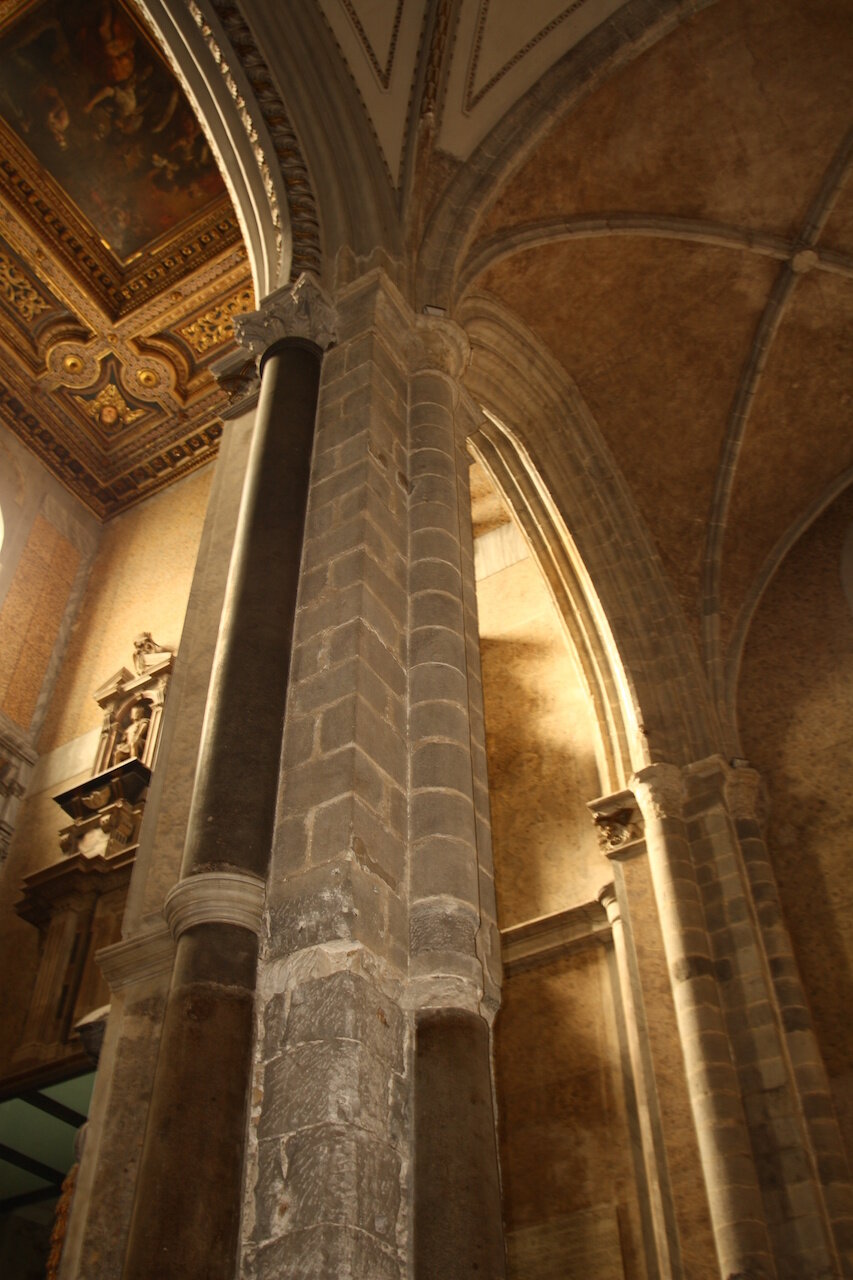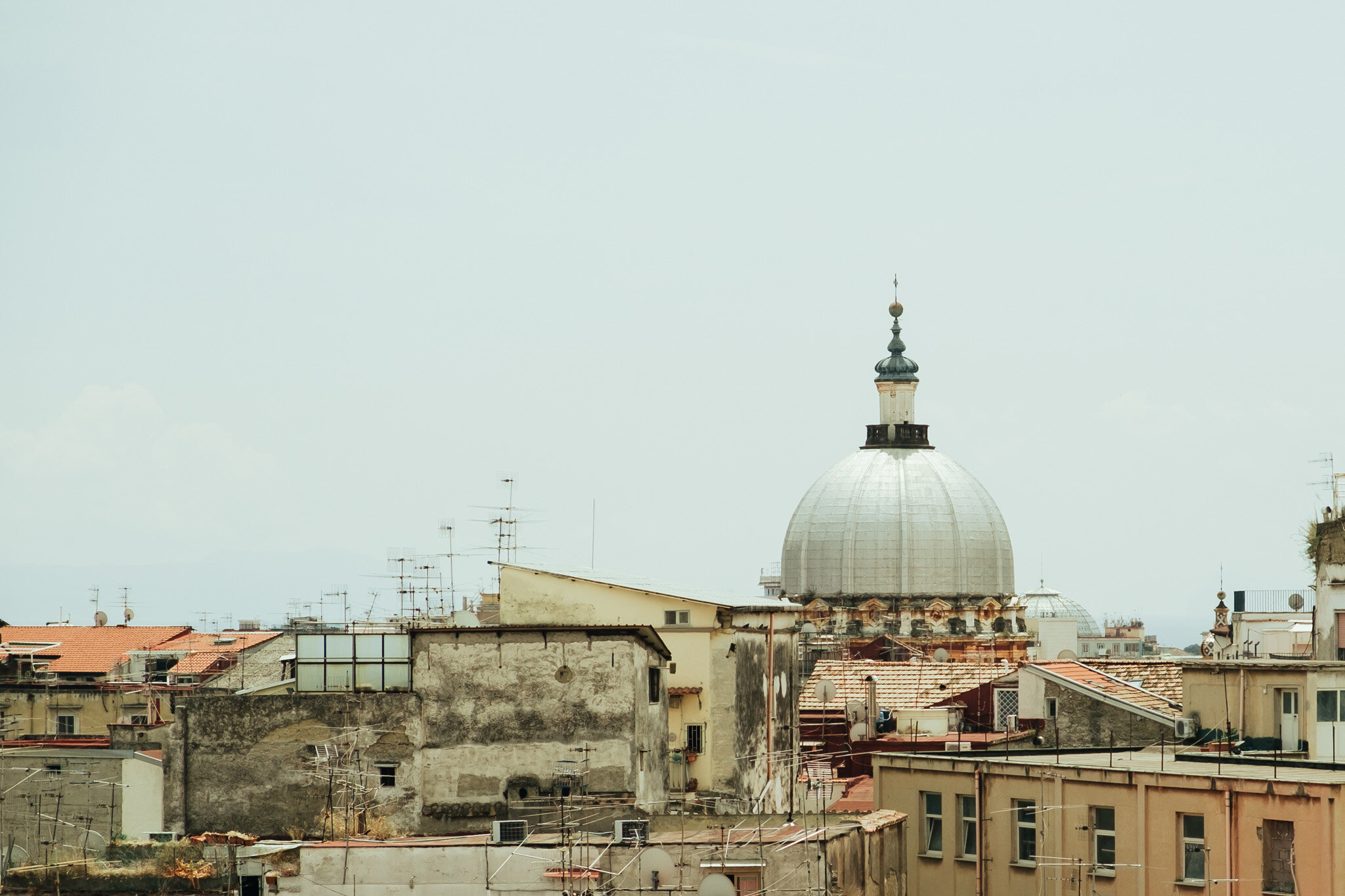A Stroll Through History at Naples Duomo
The first time I visited the Cathedral of Naples – Naples Duomo, I had this picture in my mind of the Duomo in Florence. A mammoth structure with a richly decorated facade and orange-tiled dome roof that is visible from all over the city. Perhaps the most recognizable building in the city, it is its own best billboard screaming out – Come See Me, Come See Me. You just absolutely can’t miss it.
So it was with that idea in mind that I set out to find Naples’ Duomo. Wandering down the aptly named Via Duomo, I couldn’t help but notice how narrow the street was. While that in itself is not surprising for Naples, I somehow expected the city’s Cathedral would be set apart. Situated on a street wide enough to allow the onlooker to stand back and admire an architecture I was sure would impress and inspire.
I kept thinking that at any moment I would come to an immense opening that would lead my eye to Naples’ most important religious monument. On my second pass down the street I noticed a church set slightly back in a small recess. If not for the sign in front (that I obviously missed the first time), I don’t think I would have known it was the Duomo. It’s not that its façade wasn’t impressive, but it didn’t convey that sense of pageantry I had imagined and I felt a bit cheated at first.
And then I walked in.
From the moment you step inside Naples’ Duomo you are captivated. Immersed in the wonderful world of the Baroque – or some hybrid thereof, almost seven centuries of stylistic and architectural changes are layered on top (and below) a Gothic skeleton. Highly ornamented facades that are beautiful in their own right, yet conceal the original Gothic Cathedral that was commissioned in the 13th century.
Peel away all of the Baroque ornamentation and the Cathedral’s Gothic form begins to emerge. The arcades that line each side of the nave creating the left and right aisles, the pointed Gothic arches, the clerestory, and the Latin Cross plan that was intended by the Cathedral’s original designers who were commissioned by the Angevin dynasty.
Whether by Charles I (1266 – 1285) or Charles II (1285 – 1309) is uncertain, as is when construction was completed. But it is certain that the Cathedral was consecrated in 1314 during the reign of Robert the Wise (1309 – 1343) and dedicated to Our Lady of the Assumption (all’Assunta). And some sources say it was built in honor of the 1000th anniversary of the death of Naples’ Patron Saint, San Januarius, whose remains were eventually brought here to a crypt built beneath the major altar in 1497. Just one of the many changes that would be made to the Cathedral in the ensuing centuries.
So many in fact that today, few outward traces of the Angevin’s original Cathedral remain. Nothing that is except a tiny glimpse in the back of the church in the left aisle. In a failed attempt to return the Cathedral to its former Gothic glory, a vault was stripped back exposing its original form.
Now picture the entire Cathedral that way, stark and utilitarian. The soaring interior reaching towards the heavens, and bringing back from the heavens the streaming light of God through the stained glass windows high above in the clerestory. Imagine the sense of awe and spirituality that must have instilled in the Cathedral’s parishioners.
Now imagine the site on which the Angevin’s Gothic Cathedral was built and all of the buildings, people and events that came before it. The Greek, Roman and Paleo-Christians who ruled the ancient city and whose ruins were unearthed beneath the Cathedral between 1969 and 1972. The 4th century AD Basilica founded by Emperor Constantine I at the cusp of Christianity, and probably built on the site of the Pagan Temple of Apollo. It would later be named Basilica Santa Restituta in honor of the African Martyr and incorporated into the Angevin’s new Cathedral as a side chapel. The 5th century AD Basilica Santa Stefania commissioned by Stefano I that would be demolished to make way for the new Cathedral. The Byzantine San Giovanni in Fonte Baptistery that was added to Basilica Santa Restituta in the 6th century AD and is now possibly the oldest surviving baptistery in the western world.
A mishmash of ancient Pagan temples and early Christian structures, some demolished and some preserved, yet each leaving a trace of itself somewhere within or below the Cathedral. But the Angevin’s vision for their Cathedral would be short lived, and as they did to the buildings of their predecessors, so did their successors do to theirs. The late 15th century brought the construction of the Crypt of Saint Januarius. The 17th century saw the addition of the Reale Cappella del Tesoro di San Gennaro (Royal Chapel of the Treasure of Saint Januarius) and Cardinal Carafa’s installation of a painted and gilded wood coffered ceiling concealing the original wood trussed ceiling. Not to be outdone, Cardinal Innico Caracciolo commissioned Luca Giordano to create a series of round paintings on cloth of the Patron Saints of Naples. Completed between 1676 and 1678 they still hang between the arches of the arcade.
The 18th century brought change to the rectangular piers on each side of the nave that are ornamented with the remains of 110 Oriental and African Granite columns, presumably from the destruction of Santa Stefania. In 1745, marble niches were added to house the sculpted busts of fourteen of Naples most important Bishops, among which is the bust of the first Bishop of Naples, Sant’Aspreno I. And in the 1750s, the piers were refaced in Bardiglio and white marble. And finally, the 19th century would bring us Enrico Alvino’s neo-Gothic façade that we see today, the same facade that left me feeling a bit cheated.
But after stepping inside, I felt cheated no more. In true Neapolitan fashion, the Cathedral’s slightly understated appearance, which I eventually came to love and admire, more than belied its treasures hidden within. And though the numerous modifications and changes in architecture and style over the centuries have chipped away at the Cathedral’s original design, and though it is considered by some purists to be a disappointing hodgepodge of architectural styles, it is this very layering and blending of elements that tells the story of Naples. A living, breathing, evolving reminder of Naples’ complex and layered religious, social, political, and cultural history.
A Stroll Through History at Naples Duomo was first published on NapoliUnplugged.com on February 28, 2010.
Images from Napoli
Learn More
She Studios is a participant in the Amazon Associates Program, among other affiliate programs, an affiliate advertising program designed to provide a means for sites to earn advertising fees by advertising and linking to Amazon.com and other websites. As an Amazon Associate She earns from qualifying purchases.



















